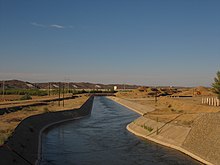Irtysh-Karamay-Urumqi Canal
The Irtysh - Karamay - Ürümqi Canal, also known as Project 635 , is a system of canals and reservoirs built for water transfer to northern Xinjiang in northern China . Water is diverted from the Irtysh River (which flows into the Arctic Ocean ) into the very dry endorheic valleys of north-central Xinjiang. There the diverted water is used for irrigation in agriculture and for the population.
In the Chinese-speaking world, the system is also known as the "Irtysh Water Supply Project". ("引 额 供水" 工程).
According to calculations by the Chinese planners, the canal will ultimately irrigate 140,000 hectares of land. A main consumer of the water is the mineral oil industry around Karamay.
history
The idea of diverting water from the Irtysh to irrigation in Central Asia was already discussed in the USSR in the 20th century . Even so, most of the Davydov Plan was never implemented. Only the small Irtysh-Karagandy Canal was built in central Kazakhstan . However, the upper course of the Irtysh is in China, and so it was the Chinese government that began implementing the major project in the 1990s to irrigate areas in Central Asia such as Xinjiang. The project was officially approved in 2000 and construction began shortly thereafter. The first diverted water reached Karamay in 2008.
Description of the system
Main channel
The 134 km long main trunk canal (总 干渠) of the Irtysh-Karamay-Ürümqi system begins at the Project 635 dam on the Upper Irtysh, in Fuhai in the Burultokay district of the Altay prefecture . The canal then moves south and south-west towards the Ulungur River . A lot of agriculture has arisen there through the artificial irrigation via the diverted water from the canal.
The main canal crosses the Ulungur River via a canal bridge . The main trunk canal is divided into two branches: a western branch (西 干渠) which flows to Karamay, and an eastern branch (东 干渠) which flows to Ürümqi.
Western part of the canal
From the junction of the three branches, the western branch flows in a south-westerly direction along the Djungarian basin at the foot of its mountains.
The western part of the Irtysh-Karamay Canal crosses the Baiyang River with a canal bridge upstream from the urban region of Urho District.
At the point where the canal reaches downtown Karamay, the 8.5 km section is called the Karamay (克拉玛依 河, Kèlāmǎyī hé ) or City River (穿 城河, Chuān chéng hé ) and is in the center of the Karamay City Park . The canal ends in Aykula Reservoir (阿依 库勒 水库) south of downtown Karamay.
Other reservoirs were built along the canal, including:
- the Fengcheng Reservoir in northern Urho
- a reservoir in the Baijiantan district
- the Sanping Reservoir (三 平 水库) in Karamay
Eastern part of the canal
From the junction of the three canal branches, the last 420 km long eastern section first leads into a tunnel. After the tunnel, the branch runs through the almost uninhabited Gurbantünggüt desert . It reaches the Tian Shan belt from settlements near Daquan (大 泉 牧场) in Fukang . The eastern part of the canal system supplies various reservoirs in Fukang via branched canal branches and then ends in "Reservoir 500" ("500" 水库) on the border between Fukang and the Midong administrative region .
tunnel
There are several tunnels along the canal, such as the Dingshan Tunnel, which is 7.415 km long.
More water supply for the sewer
The project 635 reservoir is not only intended to supply the Irtysh-Karamay-Ürümqi Canal with water, but also to ensure sufficient inflow for the Irtash River to keep local agriculture and the ecosystem alive. In order to better balance this balance, the authorities are planning a new project with the name "Project for the transfer of water from the west to the east" (西 水 东 引 工程). A canal is to be constructed to bring water from the Burqin Shankou reservoir in the Burqin River to Project 635 on the Irtysh. Although the Burqin is a tributary of the Irtysh, the two rivers converge in the city of Burqin , 100 km downstream from the Project 635 Dam. Without the “Project for the Transfer of Water from West to East” the water would no longer reach Project 635.
criticism
China's Project 635 and the resulting decreased water flow from the Irtysh to areas outside of China has been criticized by other countries such as Russia and Kazakhstan. Kazakhstan, for example, operates several hydropower plants along the Irtysh River and supplies its own water diversion system, the Irtysh-Karagandy Canal, via the river water.
See also
Individual evidence
- ^ A b Eric W. Sievers: Transboundary Jurisdiction and Watercourse Law: China, Kazakhstan and the Irtysh . Texas International Law Journal. Retrieved January 12, 2019.
- ^ Irtysh - Karamay - Urumqi Canal. Retrieved January 12, 2019 .
- ↑ 引 额 济 克 (乌) 工程: 635 工程 (Bringing Irtysh Water to Help Karamay (Ürümqi) Project (Project 635))
- ^ Karamay River Scenic Area. Retrieved January 12, 2019 .
- ↑ 顶 山 隧洞 1 标 施 组
- ↑ 额 河 建 管局 工程 建设 和 科技 发展 情况 (Overview of the construction and scientific development projects of the Irtysh Development and Construction Authority), 2010-08-05, by Irtysh Basin Development and Construction Authority (额尔齐斯河 流域开发 建设 管理局)
